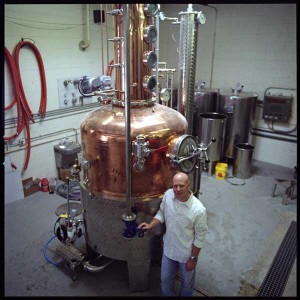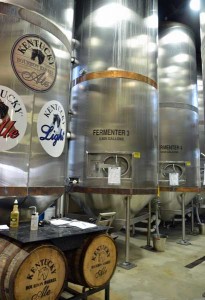Brewstilling: Making Beer And Whiskey Under One Roof
Craft Whiskey’s Intersection Between Distilling And Brewing
By Father John Rayls and Richard Thomas
In Ireland and Scotland, a common factoid learned on tours of whiskey distilleries is that in the early stages of production, whiskey and beer are essentially the same thing. Yet despite those common roots in turning malted barley into sugary wort for fermentation, even in Ireland and Scotland those two worlds, distilling and brewing, rarely mingled. Until the present day, that is, when the American craft distilling scene is bringing beer-making and whiskey-making together like never before, culminating in the rise of the place that does both: the brewstillery.
Beer + Whiskey = Brewstilling
“If you want to start a distillery, learn to brew beer.” Mark McDavid, one of three owners and Sales/Marketing Director of Ranger Creek, says this over and over, a mantra for anyone who will listen. Ranger Creek is located in historic San Antonio, TX, which enjoys long tradition of brewing beer.
However, the home of the Alamo does not apparently have a deep culture of whiskey drinking. There aren’t many cultural obstacles to enjoying whiskey here, but no real avenues for easily tapping into large pre-existing groups simply waiting for high quality whiskey.

(Credit: Ranger Creek)
Ranger Creek set out to start as a brewery, but the idea of running a whiskey distillery as well was there early on. Three guys, TJ Miller, Dennis Rylander and McDavid, worked in the corporate world while pursuing their hobby of enjoying good beer and high quality whiskey. After experimenting with individual and collaborative home brewing, they began dreaming about creating their dream come true brewstillery. While planning their business, they discovered they didn’t necessarily need to do one or the other, but could do both. With MBA’s and solid business experience to rely on, they founded Ranger Creek and set out to create beers and whiskeys they enjoy with pride.
Several important factors led to a brewstillery. For one, they discovered initial expenses were lowered doing both due to shared equipment. In addition, there’s lots of crossover between brewing and distilling and even similar taste profiles (case in point: La Bestia beer and whiskey!)
Positive cash flow, which can make or break a business particularly during startup, would be improved by having beer available for sale long before the whiskey was ready. Many micro-distilleries go the route of making vodka, gin, rum or white whiskey to generate immediate revenue, but a brewstillery can tap into the craft brewing market instead.
Ranger Creek began operations in late fall 2010. San Antonio already had a strong market for craft beer, but Texas was just beginning to open to craft distilling, so acquainting and educating consumers there was up to them. You can now sample beer, whiskey made from that beer, and a range of small barrel, big barrel and smoked whiskeys from them.
Whereas Ranger Creek was a brewstillery from its planning stage, others start as a brewery and add the craft distillery later. Alltech’s Lexington Brewing, makers of Kentucky Ale, opened in 1999, but didn’t enter the whiskey-making game until 2008, with the stills initially housed in the brewery.

(Credit: Joana Thomas)
According to brewer Ken Lee and distiller Mark Coffman, the two operations were separate and distinct, despite being under the same roof. The only commonality was in sharing some of the same people, like Coffman and Lee. It has only been with plant expansions and improvements that the brewery and distillery began sharing equipment as well, symbolized by a pipeline joining the now separate facilities. Now the facility is even the basis for a “brewstilling academy,” teaching the operational and business aspects of making beer and whiskey as a joint concern.
Some breweries add distilleries later on, and other projects start with the two operations in tandem, but for a distillery to start up and add a brewery is, at present, unheard of according to Bill Owens, President of the American Distilling Institute. Owens also related that the brewery side is usually subordinated to the distillery in a brewstillery. “My database shows 33 brewery/distilleries. Most “breweries” with a mash-tun, just create wash for their distillery. They don’t bottle or keg for outside sales. I would say just 10 do outside sales of their beer.”
Inspired By Beer
Even when brewing and distilling are not physically linked, brewing is still having a wider and deeper impact on modern whiskey-making, and it’s not hard to see why. Distillers working for the big brands might sometimes move from company to company, but spend most or all of their career inside the industry and rarely leave. As a result, only a handful of people in craft distilling have any real experience with the major whiskey companies, and most of those individuals work as consultants.
By contrast, many (although certainly not all) craft whiskey distillers have a background in either home or professional brewing. Making beer served as their trial run for making whiskey.
This played a role in the breakout of the many craft distilleries, such as Corsair and Balcones, who decided the way forward was in American malt whiskey, a sector the big players had largely neglected. Flipping through the pages of Alt Whiskey, the craft whiskey manual written by Corsair’s Darek Bell, shows just how much beer-making influenced Bell’s choices in grains and yeasts.
At a time when whiskey-making is becoming ever more innovative, reaching towards beer for inspiration is one of the things that is working. Even the major distilleries are starting to get in on the act, if Woodford Reserve’s new Five Malt Whiskey is anything to go by. While you don’t need to put both operations under the same roof to tap beer for ideas, a little synergy certainly can’t hurt.




What a great article! Thank you! I’m trying to build a brewery in a distillery in Puerto Rico!